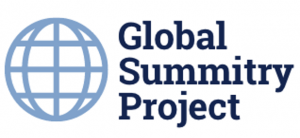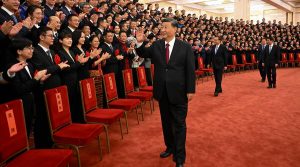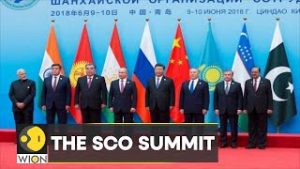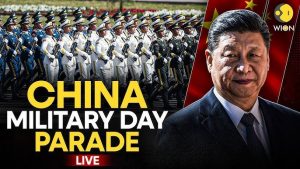
It was a confusing past couple of weeks if you were trying to understand the ‘emerging’ global order. Maybe the confusion was best captured by colleague Daniel W Drezner at Tufts University and he is also responsible for the very good Substack, Drezner’s World. Dan just recently wrote in WPR about what is, or isn’t, today’s shape and leadership behavior of the international order. Such an understanding is important as much has been written in the past week about China’s apparent emergent global role in the face of its leadership at Tianjin of the SCO, the Shanghai Cooperation Organization, and then President Xi’s determined display of power at the 80th celebration in Beijing of the victory over Japan in World War Two.
I will get to the China leadership assertion in just a moment but let’s get a grip on the current shape of the order. Now, Dan suggested:
“The death of the post-Cold War era has been proclaimed many times now, only for those reports to have been greatly exaggerated. After the 2008 global financial crisis, many observers declared the end of neoliberalism, which had underpinned the post-Cold War global order—but it persisted. Similar predictions were made after the populist shocks of 2016, and yet the global order remained largely unchanged. Even the 2020 COVID-19 pandemic failed to change things all that much.”
“What makes 2025 interesting is that for the first time, both critics and supporters of the liberal international order seem ready to deliver its eulogy. For example, it’s no surprise that Jamieson Greer, the current U.S. trade representative under President Donald Trump, would characterize the neoliberal order as “untenable and unsustainable.” Lauding what he dubbed the “Turnberry system”—after Trump’s golf resort in Turnberry, Scotland—based on high tariffs and macroeconomic rebalancing, Greer bragged, “What was long dismissed as heresy by the free-trade fundamentalists in Brussels, Geneva and Washington is now becoming conventional wisdom.””
And there is no question that the behavior of this second Trump administration is in contrast, stark contrast in some cases to administrations of the past promoting or at least declaring support for a liberal international order led, not surprisingly, by the United States.
But as Dan declares:
“Undeniably, U.S. policy preferences have shifted dramatically. That is reflected in a variety of Trump administration policies that have torched the norms that defined the liberal international order. On trade, Greer valorized a system “that is fair, balanced and oriented toward serving concrete national interests rather than vague aspirations of multilateral institutions,” while taking a gratuitous swipe at the World Trade Organization and its “old guard of trade bureaucrats.””
But as Dan suggests:
“There is a difference, however, between declaring one global order dead and declaring that a new global order has arisen to take its place. In international relations, it is a truism that destruction is far easier than creation.”
Some analysts have announced that multipolarity and the support for realpolitik, realist foreign policy, is now what drives leading and great power action. But as Dan points out:
“A more realpolitik-based grand strategy cares less about norms, values, alliances and partnerships, and more about strictly advancing the national interest. One could argue that the shift in U.S. policy preferences merely reflects the conclusion that in a multipolar world, the U.S. should behave as other states do. In other words, if Russia and China are pursuing their interests in an amoral, astringent manner, why shouldn’t the United States?”
“Concluding that the new international order is now a realist one, however, would be inaccurate and incomplete. And it is worth explaining why, to make sense of the world to come.”
So then where are we according to Dan when it comes to understanding the dynamic of the current global order. His conclusion:
“But while Carr [E.H. Carr, a British historian of the interwar years] did warn against an excessively utopian worldview, he also cautioned against a strictly realpolitik-based approach as well. As he noted, most actors in world politics need power, but they need social purpose as well.”
“Perhaps the new social purpose of today’s emergent world order will be a revised definition of sovereignty or a belief that nationalism trumps all other global values. But the point is that this remains an area of contestation. And until the great powers can either agree—or at least agree to disagree—on what comes next, the new world order will remain radically incomplete.”
And the notion of a global order where at least the leading and “great powers can agree or at least agree to disagree”, using Dan’s language, is clearly not upon us yet.
Meanwhile, China has taken the recent moment to display its leadership and proclaiming a world order distinct from that expressed by Washington. Now Xi took the opportunity of the SCO Summit to advance a different order from that expressed by Washington. As described by Sergey Radchenko at FP – Radchenko is Wilson E. Schmidt distinguished professor at the Henry A. Kissinger Center for Global Affairs at SAIS:
“Splendidly dressed dancers moved about the stage swiftly in a colorful performance as nearly 30 world leaders looked gravely on. Gathered in Tianjin for the summit of the Shanghai Cooperation Organisation (SCO), these assembled dignitaries were also taking part in Beijing’s carefully choreographed pageantry. Their presence was meant to proclaim China’s glory as the center of the non-Western world.”
Especially highlighted was the presence of India’s Narendra Modi with much attention paid by observers to the souring of relations between Trump and Modi after years of work by US leaders to draw India more closely to the West. Though much was made of this sparkling gathering, the SCO remained as it largely is a performance setting. And what was less well noted by observers was that Prime Minister Modi did not remain to share the dias at the 80th anniversary with Xi, Putin and North Korea’s Kim Jong Un, the so-called ‘axis of autocracy’. As for the strategic value of the SCO gathering, Radchenko suggests there was less to conclude from this gathering than urged by some:
“The reality is more complex than the optics might suggest. The SCO has always been less than the sum of its parts. It formerly served a very specific function: helping China and Russia manage their differences in Central Asia. The addition of India; Pakistan; Iran; and, most recently, Belarus has diluted the SCO’s mission. Now, it provides little more than a glamorous opportunity for multilateral banquets.”
And as for the 80th anniversary of the end of the war, according to Radchenko:
“Unlike Xi’s vision for a happy world of win-win cooperation, the military parade suggests the possibility that someone might well lose and that it won’t be China.”
“In place of the banalities and broader vision of the SCO meeting, Beijing offered a more provocative message endorsed by a smaller core of countries. Putin, along with Iranian President Masoud Pezeshkian and even North Korean leader Kim Jong Un were on hand for the roaring spectacle.”
“Planes flew overhead. Tanks, armored personnel carriers, laser guns, and nuclear missiles—carefully labelled in English for ease of reference—rolled across the square to the sounds of a military orchestra.”
If the intent was to underline a growing close axis of friendship opposed to the US it did, according to Radchenko, catch Trump’s attention:
“May President Xi and the wonderful people of China have a great and lasting day of celebration,” Trump tweeted. “Please give my warmest regards to Vladimir Putin, and Kim Jong Un, as you conspire against The United States of America.”
At its most strategically opportune, it would seem that Trump’s strategy of splitting Russia from China, hence the Alaska Summit, has seemingly failed. Now let’s see if Trump works in the other direction and tries to split China from Russia with recently suggested discussions over a pending grand bargain between Xi and Trump and a possible Summit.
Meanwhile, though, one cannot ignore the US lawlessness exhibited by this current Administration. The US has in many respects become the locus of disruption. Take for instance the US attack on a Venezuelan vessel in the Caribbean. As described by Rishi Iyengar and John Haltiwanger at FP:
“U.S. Secretary of State Marco Rubio said on Wednesday that destroying the boat rather than intercepting and seizing it was intended to deter other “narcoterrorists.” “What will stop them is when you blow them up,” Rubio told reporters during a visit to Mexico. “And it will happen again.””
“Tuesday’s strike is the first operationalization of Trump’s secret order to the U.S. military last month to begin directly going after drug cartels, which was reported by the New York Times but still has not been made public.”
It was startling to see, especially for those concerned over adherence to international law. The United States blew it up – what the Administration breezily declared was a boat loaded with drugs and a further declaration that the vessel was filled with terrorists as opposed to seizing the vessel and its occupants. Such lawlessness is shaking and the fact that it comes from the United States with dramatic silence from US domestic voices -in Congress especially, is just dismaying.
It underlines the current disorder but little else.
This Post first appeared at my Substack, Alan’s Newsletter
https://globalsummitryproject.substack.com/p/the-confusing-new-global-order
Image Credit YouTube
Discussion about this post

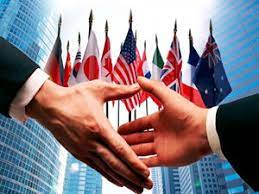
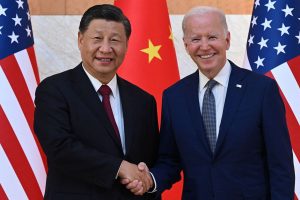
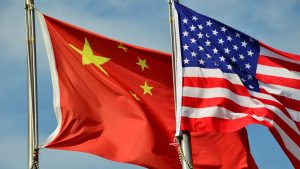 This week I, and just about everybody else holding some interest in sport, or at least in innovative commercials were distracted by the events leading up to, and including, the 58th Super Bowl. Notwithstanding the quickening approach of this Super Bowl Sunday, however, I was drawn to an examination by a number of experts for the Brookings Institution of the US-China relationship.
This week I, and just about everybody else holding some interest in sport, or at least in innovative commercials were distracted by the events leading up to, and including, the 58th Super Bowl. Notwithstanding the quickening approach of this Super Bowl Sunday, however, I was drawn to an examination by a number of experts for the Brookings Institution of the US-China relationship.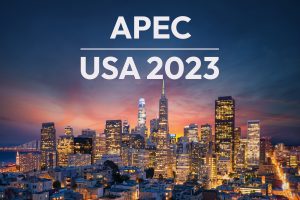 Doing some quick catch up on the APEC Summit that was held between November 11th and 17th in San Francisco. The main event, as it turned out, was the much discussed bilateral summit between China’s Xi Jinping and US President Joe Biden. While the Indo-Pacific Economic Framework for Prosperity (IPEF) meetings to receive some attention – more for what didn’t happen than what was secured – the APEC gathering activity was dominated by US-China Bilateral Summit and there was some attention paid to the other bilateral Summit of note that between President Xi and the Japanese Prime Minister Fumio Kishida.
Doing some quick catch up on the APEC Summit that was held between November 11th and 17th in San Francisco. The main event, as it turned out, was the much discussed bilateral summit between China’s Xi Jinping and US President Joe Biden. While the Indo-Pacific Economic Framework for Prosperity (IPEF) meetings to receive some attention – more for what didn’t happen than what was secured – the APEC gathering activity was dominated by US-China Bilateral Summit and there was some attention paid to the other bilateral Summit of note that between President Xi and the Japanese Prime Minister Fumio Kishida.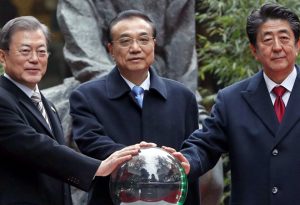 While I have suggested earlier that I don’t think an initial focus on building regional or multilateral institutions is necessarily the best first step in global governance and possibly a means to ‘tone down’ geopolitical competition rhetoric and action, I am now about to contradict myself and this position. For, in the end, there are some obvious regional and international institutions that could encourage collaborative action and push global governance collaboration. And, in fact, I have in mind an obvious one that has – as a current Chinese slang term might well describe it – ‘tang ping’ 躺平 – or ‘lying flat’. It is the Trilateral Summit.
While I have suggested earlier that I don’t think an initial focus on building regional or multilateral institutions is necessarily the best first step in global governance and possibly a means to ‘tone down’ geopolitical competition rhetoric and action, I am now about to contradict myself and this position. For, in the end, there are some obvious regional and international institutions that could encourage collaborative action and push global governance collaboration. And, in fact, I have in mind an obvious one that has – as a current Chinese slang term might well describe it – ‘tang ping’ 躺平 – or ‘lying flat’. It is the Trilateral Summit.